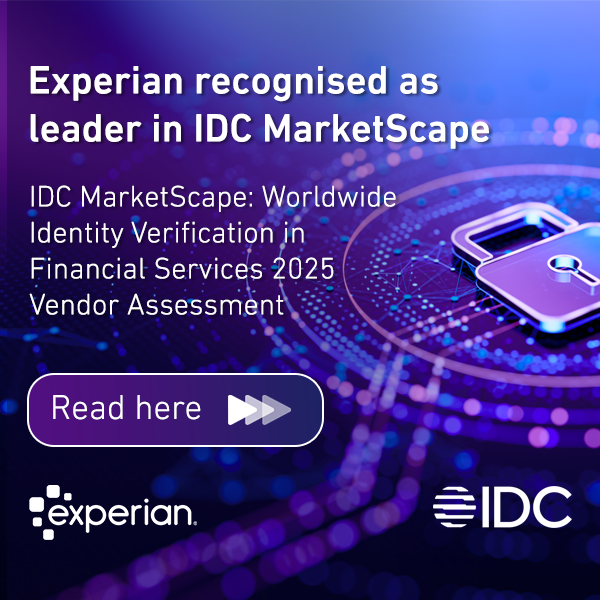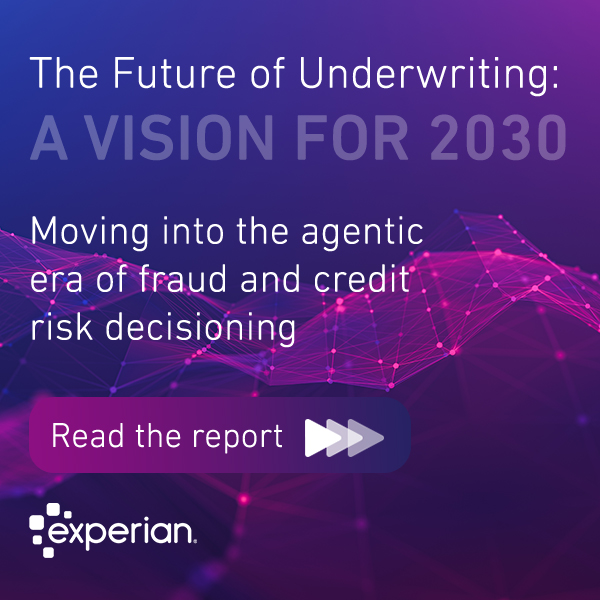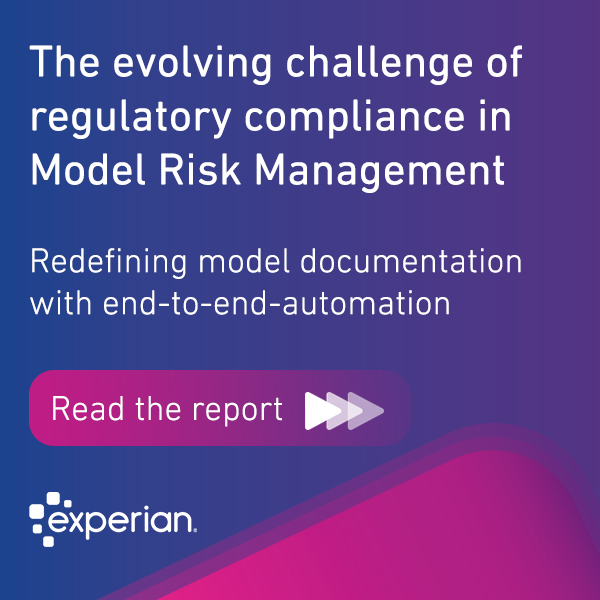Search Results for: ai

In this episode of Insights in Action special podcast series “Women Making Waves in Tech”, I had the chance to talk to Marika Vilen, Global SVP of Partnerships and CrossCore Platform Commercialization for the Experian Identity & Fraud business, about the importance of collaboration to drive innovation forward and shares her learnings on how to be and remain truly connected to clients, colleagues, and partners in today’s digital-first world. This 20-minute conversation offers some key learnings on the importance of collaboration for personal, professional, and business growth. Reflecting upon everything that has changed over the past year, Marika shared some of her key learnings from managing a growing partners ecosystem in a virtual, ever-changing environment. “We are experimenting this sort of continuum between our personal and professional lives. Somehow, it's become easier to share who you really, as since we are all working from home, the barriers between professional and personal lives are down; mixing that persona that you’re at home versus the one you’re at work. And I think this is a positive development. Especially, I think it can be very positive for women.” Innovation is often the byproduct of people collaborating and working together Over the course of 20 minutes, the conversation moved from how innovation is cultivated in different ways, drawn from collaboration, driven by different people and by those people working together, to the advantages of partnerships to accelerate business growth and transformation. “Working in a partner function within the organisation, you have a great opportunity to bring in an outside perspective at much quicker pace, because you’re introducing something that someone else has already done. You can bring along a smaller company, add their input to your product development and together create and provide something new, exciting for your customers.” For Marika, it is key to realize that “the projects that you work on to drive innovation and push the boundaries of what you think is possible are often a byproduct of people working together.” Discover other stories from the Women Making Waves in Tech podcast series Access all episodes of Insights in Action on Soundcloud, Spotify, Google Podcasts

In a recent interview, I had the opportunity to talk to Chris Preimesberger of eWeek about the latest Global Identity and Fraud Report. We discussed some of the business challenges executives face in the increasingly complex space around fraud mitigation while reflecting on how and why the pandemic has shifted the fraud landscape. Market movement – more of us were online than ever before With so many of us at home during the pandemic, access to digital services and the purchasing of goods online increased dramatically. According to our research, businesses responded by investing in supporting services to accommodate the increase in traffic. We saw a lot of action from businesses around how to improve the customer experience while getting a better understanding of who the customers are and how to get their online problems resolved. Our January research wave showed that with all this investment into customer experience and enablement, there were some key areas of investment. Analytics – the use of automation and AI to help make smoother, better decisions for customers – ranked highly in business priorities, but this approach does not exist in isolation. Businesses are also doubling down on support staff to ensure that consumers have a way, if there’s an anomaly in the process, to be able to respond. Whether that’s password resets or call centre staffing, there’s a desire and there’s an intention by businesses to increase staff on digital support. A shifting sense of recognition We also surveyed consumers on their preference for passwords versus other security methods. Security remains the top consideration for consumers when online, above others such as convenience, but interestingly, for the first time in four years password protection did not appear in the top three preferred security methods, favoring instead a more friction-less approach to authentication. This shift in consumer attitudes towards what we call invisible security paves the way for businesses to start to adopt more sophisticated or nuanced approaches to authentication and security. They can start to leverage behavioral analytics or device intelligence recognition without intruding on the user experience. Normalizing biometrics and the importance of a layered approach Customer attitudes around traditional biometrics are very positive – it’s one of the top-rated preferred security methods thanks to the providers that have popularised it through the mobile devices we all use every day. However, the challenge with pure biometrics is always at the point of enrolment – how do you ensure that the right person is assigning their biometric to a device? This is why a layered approach to security that incorporates traditional identity verification or authentication processes along with more advanced technical elements like behavioral analytics, device intelligence, network access, and transactional context is so important. For example, “Is this device associated with David’s account? Is this actually David or a bot? How does David hold his phone?” This includes layers of security that are considered privacy-safe, and may not even require traditional identity data but have anonymous attributes that can be associated with how someone interacts. This will be pivotal in allowing businesses to enable a more comprehensive, pliable, and flexible approach to security rather than relying on rigid but easily broken mechanisms that we’ve been using for a long time. Why the types of fraud will change as the world seeks normality Over the last year, fraudsters focused their energies on stimulus funding and many other forms of low-hanging fruit that they could easily go after, pulling back from their activities in traditional financial services or e-commerce. As the pandemic eases off in many parts of the world, fraudsters are likely to increase their activity in these areas once again as stimulus programs close down, and as consumers increase their spending. Fortunately, we found that more than half of businesses will continue to invest in fraud prevention solutions over the coming year. Fraud trends to watch in 2021 As we look at the direction in which fraud is moving, we know there is an increase in several types of fraud as we navigate what is becoming the post-pandemic world of 2021. Account takeover fraud is set to be on the rise again this year. This is when stolen credentials are used to gain access to systems. Account origination or new account opening fraud will also be on the increase, where fraudsters use stolen identities to create brand new accounts, including a rise in synthetic identity fraud. Card not present online transactions is something we will see in huge volumes given the explosion of online traffic over the last year, which will undoubtedly include an increased volume of fraudulent transactions. Stay in the know with our latest insights:

Experian has been named a technology leader in Quadrant's 2023 SPARK Matrix: Digital Decisioning Platforms Experian ranked second overall in the latest Juniper Online Payment Fraud Market report, just behind LexisNexis Risk Soultuons and ahead of FICO and TransUnion Experian has been named an Overall Leader by KuppingerCole in its latest Fraud Reduction Intelligence Platform evaluation Ascend Intelligence Services suite of analytics solutions has been named Best Consumer Lending Product in the sixth annual FinTech Breakthrough Awards 2022 Sure Profile wins Platinum for Fraud & Security Innovation of the year at the Future Digital Awards 2021 CrossCore wins Platinum for Fraud Detection & Prevention Platform of the year at the Future Digital Awards 2021 Ascend Intelligence Services wins Gold for AI Platform of the year at the Future Digital Awards 2021 Ranked #11 on the IDC 2021 FinTech Top 100 2021 CIO 100 Awards: Recognized Atlas Credit for their use of the Experian Ascend Intelligence Platform 2021 Winner of the Artificial Intelligence AI Excellence Award 2021 Winner for Best Data Analytics Offering at the Global Retail Banking Innovation Awards 2020 Gold Winner of the Team-Department of the Year category for Decision Analytics at Info Security PG’s Global Excellence Awards 2020 Winner in the ‘Organization’ category for Decision Analytics at Big Innovation Awards Shortlisted for Innovative Product of the Year in 2019 CyberSecurity Awards Named in Forbes 2018 as one of the World’s Most Innovative Companies for 5 Consecutive Years Recognized as an Innovator in the 2017 Fraud Detection and Prevention market Experian CrossCore wins the Javelin Strategy Best Overall Identity Proofing Platform award Top Vendor in the 2017 Online Fraud Detection and Prevention Leaderboard 2017 Gold Winner for Product Management Department/Team of the Year ‘Best Credit Reference & Information Solution’ in 2017 Credit & Collections Technology Awards 2017 Finalist for People’s Choice Award at the MRC Technology Awards 2017 Finalist in the Big Innovation Awards 2017 Winner for Product Innovation in The World Business Awards 2017 Gold Winner for Security Product Management/Development Team of the Year at InfoSecurity Business Awards 2017 Gold Winner for New Products and Services at InfoSecurity Business Awards 2017 Bronze Winner for New Product or Service of the Year Banking CIO Outlook Top 10 Security Solution Providers 2016

In a recent DataTalk interview, I had the chance to reflect on and discuss how we define digital identity these days. The big digital shift we have been immersed in since the coronavirus pandemic started has certainly changed the way we create, relate to, and protect our identities online. One of the most interesting aspects of this change is that the majority of people don't think about how they're being represented online; there's a lot of information that represents us that we don't typically take ownership over. We don't tend to think about that, but it's absolutely vital to the whole process. In this regard, this year’s Global Identity & Fraud Report shows that 8 in 10 businesses now have a customer recognition strategy in place, up 26% since the start of the pandemic. Many companies also developed digital strategies as they strove to improve their online experience and provide security and fraud prevention measures when customers needed it most. That certainly marks an inflection point, as for 55% of consumers globally, security is the most important element of their online experiences. Covid-19 has changed the definition of digital identity The covid-19 pandemic has impacted the way people rely on technology for their day-to-day interactions, from shopping to banking to digital identification. It’s particularly interesting seeing how for people that weren't really engaged online before, that weren't big believers in the whole idea of buying goods and services online, the risk of walking into a store during the pandemic outweighed their fears of shopping online. That translated into about 20% of the population moving their shopping online in the last twelve months, per Experian’s 2021 Global Identity & Fraud Report. Looking ahead, the expectation is that 46% of consumers worldwide purchase and do more things online, even when physical stores and venues are safe to go back in again, meaning that people’s digital footprint is growing faster than ever. In this context, we could define digital identity as how we represent ourselves in a digital environment and how do people recognize us. For example, in the same way that years ago a good way to identify someone was looking up that person’s address and phone number, as landlines become a thing of the past, it’s possible to validate someone’s identity online using data gathered from mobile phones. The majority of people wouldn’t share those with anyone else, so their mobile phone becomes a really strong representation of their identity in the digital world. Today, opening our mobile phones with our thumbprint or via facial recognition feels very normal (that’s already part of our digital identity). Something similar happens with voice biometrics, IP addresses and device information, sources for identity data that are gaining prevalence in the digital-first world. All this identity data that is generated in the background starts to add up and creates uniqueness, helping people get recognized digitally. Related Content The race to Digital Identification, a DataTalk with Eric Haller What is digital identity and why should we care What are consumers the most concerned about when it comes to digital iterations

As part of our Women Making Waves in Technology special podcast series, I had the chance to talk to Jayme Beck, Vice President of Global Marketing & Customer Experience at Experian Decision Analytics about how innovation translates into tech marketing and customer experience. In this 20-minute conversation, Jayme shares her passion for connecting with people and reminds us of the importance of looking for that human element, as behind every screen, behind every algorithm, decision, email, there is a person. Innovation comes in all sizes, also in marketing This podcast also explores topics such as managing innovation from a marketing standpoint, especially nowadays that everyone is talking about omni-channel experiences. In this day and age, it’s all about embracing a growth mindset and bearing in mind that innovation comes in all sizes. The pandemic has resurfaced the importance of communication, and while communications practice and discipline isn’t something that comes naturally to everybody, this is a great time for communications and marketing professionals to grip their place in the innovation cycle. For Jayme, this starts with letting go of the idea of perfection and overthinking. Adopting a ‘try & learn’ mindset is the next step. “I like to revisit a talk from this baseball coach I know, where he encourages everyone to let go of the idea of perfect and put one foot in front of the other, and see where that takes us to.” Discover other stories from the Women Making Waves in Tech podcast series Access all episodes of Insights in Action on Soundcloud, Spotify, Google Podcasts

Digital interactions have been the norm for some time, and have recently accelerated due to the pandemic, surfacing digital identity as a fundamental focal point for businesses. A shift from analog identity to digital is happening organically due to digital demand, but the necessity of safeguards from businesses and policymakers, and an understanding of what it means to have a digital identity from consumers, make this a complex and increasingly important topic. "Sometimes it's easier to think about analog and how that might relate to digital. Our analog life, our identity, is pretty straightforward. We're all used to showing a driver's license, an identity card, or a passport. It's been authenticated by somebody that we trust like the government. It's something that we use as an entry point to open up our first checking account at the bank or when we go to the doctor's office and we provide insurance and our identity. In the digital world, it's very similar. If you think about that provenance or that trusted source of identity, it often starts with some things that we don't even see. That digital footprint is growing and expanding into a lot of pieces of information that most of us aren't familiar with or think about. That data becomes the gateway to how we access goods and services in a digital environment." Eric Haller In this CXO Talk, Michael Krigsman asks Eric Haller, Executive Vice President and Group Head of Experian DataLabs, what it means to have a digital identity and why it's important. They take a look at the following topics: What is digital identity? How do you establish digital identity? How to improve digital identity? How can we protect against AI-generated deep fakes? What is the intersection of digital identity and GPT-3? Blockchain and digital identity Societal implications of digital identity Advice to businesses and policymakers on digital identity

There's been lots of discussion about what a return to normal will look like as we transition out of the global pandemic—and much remains up the air. However, our recent consumer and business surveys paint a picture that merits the attention of financial service and credit companies. The big takeaway: The Covid-19 crisis has bifurcated consumers, created extremes on both sides. On the one hand, many individuals coming out of the pandemic have more cash than they had going in. The crisis didn't impact their income, and instead, they've spent the year spending less than they usually would due to work-from-home mandates and local lock-downs. Our consumer survey from January 2021 shows that financial challenges have eased for younger consumers and higher-income households. Yet, at the same time, there's also a contingent of consumers who continue to struggle. One in three of our survey respondents reported that they still have financial concerns and a similar percentage are worried about their employment. We anticipate that the demand for support, service, and credit will be high from each side. So how can companies respond to the heightened need for credit products while continuing to service consumers who may need support? This is where digital solutions make all the difference. By employing digital onboarding and decision automation tools, you can rapidly increase your capabilities while also improving the online customer experience for all. A return to spending The U.K. provides a glimpse of what a staggered return to normalcy may look like. When shops and restaurants re-opened for business in mid-April, lines of people streamed out the doors and flooded the streets. With the country's re-opening culminating in June, many consumers will be looking to resume spending on items and projects that they've neglected since the pandemic's start. For example, our survey data reveals that consumers are becoming less cautious with their finances in general. Fewer people report that they're cutting back on discretionary spending and there's a decline in consumers putting money toward emergency funds and drawing funds from savings accounts. These consumers may be gearing up to spend more. And companies that can anticipate their needs and meet them proactively will be positioned to win and keep their business. Solutions for pent-up demand Many businesses are already preparing for this new wave of demand. Consider that eight out of 10 businesses report that they're turning to cloud-based decisioning applications to improve the customer journey. In doing so, companies are giving themselves much-needed flexibility right when it's needed most. They can dial up their online capabilities based on demand and then dial down if it drops. At the same time, these automated solutions enable companies to deploy their staff to customers who do require personal attention. It's a divide-and-conquer model that keeps the customer at the center. In addition to utilizing the cloud, more than 40% of companies say they leverage AI to improve the customer experience. The AI component enables companies to provide personalized options for consumers and create customer journeys that are far more relevant. The timing for such personalization couldn't be better. In our research, a growing percentage of consumers indicate they're willing to share more personal data about themselves in exchange for improved experiences and added value. Building solutions that work—for everyone The pending volume creates a significant growth opportunity and highlights why digital solutions are a must. Companies that provide the best digital service to customers will garner their trust, loyalty, and even referrals. This yields more demand, increasing the need for scalable, cloud-based onboarding and decisioning even more. Amid this activity, you'll want to focus on getting the most from your digital tools. To do so, consider: Leveraging data for improved credit outcomes Evaluate your end-to-end customer journey, looking for ways to utilize data and increase personalization at every juncture. You'll improve the customer experience and provide more relevant offers. The right data also provides a holistic picture of customer credit risk and ensures you're not creating problems for the future. Utilizing low-code solutions so employees can dive in Digital onboarding and decision automation can be game-changing for the customer experience. But if it's hard for employees to use, then that effectiveness takes a hit. Look for solutions that your employees can use off the shelf. The ability to generate customizable reports and execute on ideas and strategies without involving IT at every turn is essential. Recognizing limitations and potential bias Evaluate your analytics models and look for areas of limitation or potential bias. You want to ensure that you're providing access to credit to all eligible customers and not inadvertently excluding specific demographics. Building capabilities that put you ahead of the market The pandemic provided many lessons—and the value of anticipating demand or potential problems was one of the most important. The crisis is waning, but the financial consequences will continue to reverberate, especially as various government aid programs come to an end. Focus on improving your analytics so that they can better describe what's happening now and predict pending changes in demand and shifts in your portfolio. By and large, consumers are moving forward after a challenging year. Prioritize your digital solutions to make sure you can meet their needs regardless of what the future holds. Stay in the know with our latest insights:

In our first episode of the Women Making Waves in Tech podcast series, we hear from Shobana Balasundaram, Director of Product Management at Experian Global Decision Analytics. Shobana leads the product roadmap for PowerCurve Suite, Experian’s award-winning decisioning software platform. Shobana’s passion for introducing new solutions and product features is contagious: “During my time managing this collection of software solutions, I have had the chance to bring some advanced analytics and machine learning features to market. Indeed, some of the new product features that I have launched have driven nearly half of our revenue growth in the past few years, which confirms that decisioning software is a growing area. And I love my job!” Blending business strategy and tech advancements Shobana discusses what it takes to bring business strategy to life by applying the latest tech advancements. “It’s all about transforming an idea into a product and putting it in the hands of a client so they can deliver value to their customers,” explains Shobana. In her current role with the global product management team for decisioning software, Shobana is responsible for thinking about what kind of features to build into the product and forecasting the level of growth it will generate. That also involves addressing the market’s and competition’s reactions. But for her, the part she enjoys the most is “taking an idea, thinking about what is the possible problem you're solving and turning that into a product feature. Getting that idea-turned-into-a-solution in the hands of a client is a very satisfying experience, end-to-end.” Access all episodes of Insights in Action on Soundcloud, Spotify, Google Podcasts

At Experian, we have a long history of driving positive change in society. For example, our founder Si Ramo was one of the original thinkers around a cashless society much like the one that we are headed to today. Indeed, everything we do today as a company is built upon a foundation of data and information technology and anchored on the mission of giving consumers access to the financial products and financial information that they deserve. All of that while enabling consumers to protect their identities and to help businesses achieve their outcomes. Experian Decision Analytics’ mission is taking the complexity out of decision-making, enabling businesses to drive meaningful outcomes for consumers in moments that matter. We achieve that by making sense of that data, by applying advanced analytics and technology in ways that help businesses better serve their customers. Cloud-based technology helps make smarter, quicker customer decisions We are committed to extending our expertise and capabilities to businesses of all sizes so they can take advantage of a range of simple, affordable, and configurable solutions. That means that what was once only available to very large businesses is available to all, and that’s better for consumers. For us, helping businesses serve the needs of more customer segments, with confidence, is paramount. Leveraging decisioning software, rich data sets, advanced analytics, and cloud-based technology, we empower customers to make great risk-based decisions quickly, easily, and safely. That translates into innovation at scale, a lower total cost of ownership for clients, and greater access to the most effective fraud protection methods. We do this to help businesses lend more effectively, minimize and detect fraud losses, and comply with regulatory and privacy requirements. But, more importantly, we do this to help them deliver great experiences to their customers. Ultimately, all of that work helps society to flourish. More resources on digital transformation and automated decision management: Fair and explainable artificial intelligence is accelerating industry transformation How digital transformation is defining a new way to do business Automating Fairness: Using Analytics to Help Consumers in Pandemic Era

As consumers shop, bank, and pay online during the global pandemic, steps are being taken to return to more business as usual. But, what should businesses expect around consumer digital preferences post-pandemic? Steven Wagner, Global Managing Director of Decision Analytics, recently spoke with Jill Malandrino of Nasdaq Trade Talks about recent survey findings and overall trends to watch out for. Here are highlights of that discussion: Research trends indicate a continued and persistent surge in online transactions and digital payment mechanisms The current environment has been a tipping point for consumer trust in online transactions A secure environment through continuous and passive authentication is key to meeting online consumer demand There is a direct correlation between consumer trust in their online environment and their willingness to provide data to secure a transaction Businesses need to invest in AI that provides a good consumer experience -- from chatbots to machine-learning models that impact consumer treatment in real-time Watch the full episode now: Related stories: New research available: 2021 Global Insights Report Parting ways with old forms of managing credit risk online Why the new era of customer experience includes passive authentication

At a time when the digital transition is in full swing, accelerated by the rapid change brought by the pandemic, the role of technology architecture seems to gain a renewed importance. This discipline is all about finding solutions to the challenge at hand by bridging the gap between business needs and technological enablement. In the latest Insights in Action podcast series ‘Women Making Waves in Tech’, we hear from Aruna Chalasani, senior software architect at Experian Global Decision Analytics. In this 20-minute conversation, she talks us through her experience driving innovation in highly diversified, geo-distributed teams and shares key learnings and takeaways about driving product vision with the customer front and center. It’s all about customer enablement Aruna highlights how, over the past year, the lifespan of innovation has continued to shorten. That means a shrinking timeframe to enact innovation from a technology perspective, whether that’s migrating to the cloud, leveraging machine learning, refining the customer experience, boosting data integration, or infusing automation at scale into the business. This fast-tracked drive into the digital world has also brought an increased digital risk. Security remains paramount, and they must look at it from a holistic perspective. These new innovation parameters call for robust customer enablement – self-service keeps gaining traction as a proven way to enable organizations to meet consumer demands at the speed of change, while more and more organizations seek the benefits of cloud-based solutions and automated decision management. For technology architects, driving innovation these days is about responding to customers’ needs even quicker, yet without losing sight of security, scalability, usability, and efficiency gains. Listen to the full podcast Access all episodes of Insights in Action on Soundcloud, Spotify, Google Podcasts

In honor of International Women's Day, we've curated a list of our top stories from over the past year authored by women leading change in the data, analytics, and technology industry. Right offer, right time: What organizations really need from digital decisioning software By Donna DePasquale, executive vice president, Global Decisioning Software The true potential of digital decisioning brings to mind the intrinsic reward of talking with someone that really gets you. It’s that “aha” moment when they say just what you needed to hear or offer the help you wanted—without you having to ask. The rise of digital decisioning software enables organizations to scale a similar level of personalization, offering customers what they need at the exact right time. And organizations that do it well dramatically improve the customer experience and drive loyalty and revenue in the process. But realizing this promise takes the right tools. The most effective decisioning platforms include a powerful combination of data, analytics, and technology. Equally important, the software must allow non-technical users to update and change strategies to better meet customer and organization needs without burdening IT. …Read more Consumer demand for digital will persist and the customer journey will be redefined By Stacy Schulman, senior director of marketing, Global Decision Analytics With the turn of a new year, there’s positive news that a vaccine is making its way to local communities. As businesses set their goals and strategic agendas, a top question comes to mind: what consumer trends are here to stay post-pandemic. While it’s difficult to predict the future, we believe many of the digital behaviors and expectations observed in the past year will persist, calling upon businesses to do more with their data, analytics, and technology to bridge online and offline customer experiences. For over the past year of the pandemic, we’ve conducted a study that looks at the impact of Covid-19 on consumer digital banking and shopping behaviors and businesses’ strategies and priorities to support their customers. …Read more Insights into Action podcast: Present and future of digital identity with Nick Maynard and David Britton By Angela Gonzalez-Rodrigues, podcast host and marketing manager, Global Decision Analytics The concept of digital identity and the ways it can be applied has been discussed for many years. While this has traditionally been more of a philosophical discussion, this notion has beginning to shape over the past twelve months, making waves across markets and driving, making many in the industry wonder what has changed to prompt that shift. In a recent episode of the Insights in Action series, Nick Maynard from Juniper Research and David Britton from Experian Decision Analytics explored the pandemic’s transformative effect on the prospects of digital identity. Over the past year, reliance on e-commerce has increased significantly increased globally, boosted by new consumer and business needs and efforts to observe social distancing and cope with the side-effects of lockdowns. …Have a listen Has my data lake turned into a data swamp? By Andrea Nighswander, senior manager of solution strategy, Global Identity & Fraud In many respects, the explosion in the type and volume of customer data businesses gather to facilitate security, ensure a convenient, user-friendly approach to customer interactions, and personalize interactions is a double-edged sword. In an era when businesses are awash in data, customers’ expectations regarding its use continue to grow. Nonetheless, when it comes time to recognize a consumer by utilizing the data, there is a disconnect between how confident businesses are in their ability to recognize the consumer and the consumer’s confidence in businesses’ ability to do the same. According to our global research, 95% of businesses say they can recognize their customers yet 45% of consumers don’t feel recognized. …Read more Biometrics as the catalyst for trust in a socially distanced world By Gena Boutin, vice president platform go-to-market success, Global Identity & Fraud According to our global research, 81% of consumers view physical biometrics as the more secure form of identity verification Conversely, as user IDs and passwords become more exposed to fraudsters, various organizations across industries are using biometrics to develop next-generation identification controls that combat fraud, make transactions more secure, and create trusted enhanced customer experiences. Driving adoption is certainly key to effect change. The good news is that biometric authentication is already part of our daily lives. Facial recognition to unlock mobile devices and fingerprint scanners to facilitate purchases are only a couple of examples of how engrained biometrics already are in our daily lives. …Read more Other related stories: Women Making Waves in Tech, a podcast series Game changers: Women in AI Video interview of Marika Vilen at Experian on identity verification




